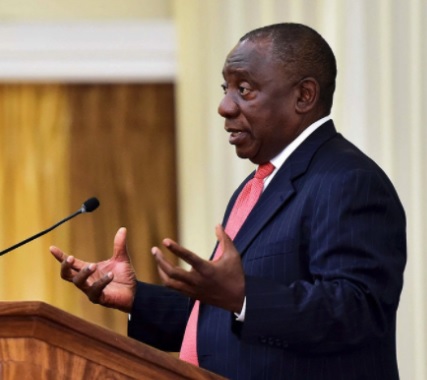

Follow us on:  
|

“This is a Budget that plants a seed for renewal and growth.” Tito Mboweni

Should Ramaphosa establish a Growth Commission? [GCIS]
There was no way that the Treasury would be able to provide R100bn in debt relief to Eskom in one go, so instead he provided R69bn spread over three years.
To fund this he would not increase tax brackets to compensate for higher salaries, as well as reducing expenditure by R50bn by reducing the public sector wage bill.
In a nod to his esteemed predecessor Trevor Manuel, who had been the longest serving Finance Minister from 1996 to 2007 and provided plums to the media at the February 2003 Budget, he brought a seed of the aloe ferox, which he said was resilient, sturdy and drought resistant.
“Today, I bring you a seed to prove that if we plant anew, we can return to those plum times,” he said in his speech.
Mboweni said the Budget was built on six fundamental prescripts:
Achieving a higher rate of economic growth; Increasing tax collection; Reasonable, affordable expenditure; Stabilising and reducing debt; Re-configuring state-owned enterprises; and Managing the public sector wage bill.
Treasury has forecast GDP growth rising to 1.5 per cent this year from an estimate of 0.7 per cent last year. Growth then accelerates gradually to 1.7 per cent in 2020 and 2.1 per cent in 2021.
This is however lower than the forecasts given in October’s Medium Term Budget Policy Statement (MTBPS) which were 1.7 per cent for 2019, 2.1 per cent for 2020 and 2.3 per cent for 2021.
It was this downgrade in the growth trajectory that initially resulted in a selloff in the foreign exchange market to R14.37/US$1 from R14.14/US$1 before the speech, but once the foreign exchange traders realised that the Budget was in fact aimed at structural reforms and addressed the issue of debt relief for Eskom in a sustainable way, then the traders reversed direction and the rand ended stronger below R14/US$1.
2003 was a watershed year when the South African economy moved from the fiscal austerity of the Growth Employment and Redistribution (GEAR) policy introduced in 1996 to a higher growth path.
 Both Treasury and the Reuters consensus forecast consistently under-forecast GDP growth in the years 2004 to 2007 and Mboweni will be hoping that in a similar manner, 2019 has the same kind of watershed effect as the government provides regulatory certainty and a conducive investment climate.
Both Treasury and the Reuters consensus forecast consistently under-forecast GDP growth in the years 2004 to 2007 and Mboweni will be hoping that in a similar manner, 2019 has the same kind of watershed effect as the government provides regulatory certainty and a conducive investment climate.
In his February 7 State of the Nation Address President Cyril Ramaphosa set a target of getting South Africa to a ranking of 50 by 2022 in the World Bank’s Ease of Doing Business from a current 82.
Treasury said South Africa’s slide in competitiveness reflects both a failure to implement key reforms domestically, and the speed at which peer nations such as Kenya, Mauritius and Rwanda have implemented their own reforms.
The deterioration is also in response to corporate scandals, auditing firm failures, widespread corruption in both the public and private sectors, and the perceived erosion of government’s commitment to macroeconomic stability.
In terms of improving tax collection, Mboweni said the Large Business Unit would be relaunched in April 2019, while an Illicit Economy Unit, which was launched in August 2018, will combat the trade in the multi-billion rand illicit trade in cigarettes.
In terms of expenditure, the baseline expenditure has been adjusted downwards by R50.3bn, but this saving was offset by providing debt relief to Eskom of R23bn per year for the next three years, so the net effect is a R16bn increase in the expenditure ceiling.
He quoted Charles Dickens’ Oliver Twist when he said the State-owned Enterprises (SOE) kept coming to him and saying: “Please Sir, may I have some more”, and to cater for this there is a small increase to R13bn in the contingency reserve from zero in this fiscal year.
Treasury will help SOEs to be reconfigured, but the quid pro quo is that if they ask for money, then Treasury will appoint a Chief Reorganisation Officer or CRO. In that respect, Eskom will be the guinea pig and I expect an announcement shortly.
In terms of stabilising debt, the Budget projects that it will not exceed 60 per cent of GDP in the next three years. In October 2015 the debt to GDP ratio had been expected to stabilise below 46 per cent.
The public sector wage will be reduced by offering early retirement to public servants. Ordinary public servants can take early retirement at age 55, while teachers can take early retirement at age 45. That is likely to reduce the public sector head count by some 30,000.
In that respect the ratings agencies and everybody else will be watching closely as to how the government manages the Eskom reconfiguration, as that will be top of mind for the next few months.
Once Eskom achieves an Energy Availability Factor near 80 per cent from the current 63 per cent, then the focus will shift to the regulatory reforms needed to make it easier to do business.
Helmo Preuss in Pretoria, South Africa for The BRICS Post